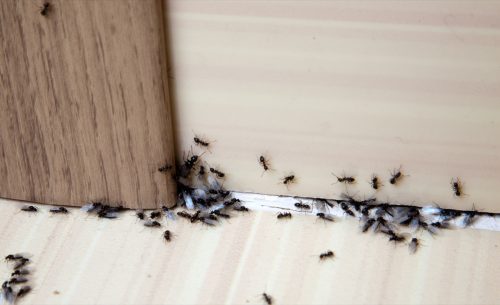If You Live Somewhere Hot, Watch Out for This Venomous Spider in Your Home

Saying “it’s a hot one” is an understatement for most of us this summer, as a large majority of the U.S. has been hit by a wave of extreme heat the past few weeks. According to CNN, more than 90 million people across the country are in areas that are under heat alerts for temperatures that are dangerously high. And while there are many things to worry about in this kind of weather—from dehydration to power outages—you might not realize the extreme heat could also bring certain unwanted pests inside. Read on to find out if you need to be on the lookout for one venomous spider in your home right now.
READ THIS NEXT: If You Live Here, Watch Out for This Poisonous Spider in Your Home.
You’ll likely notice more pests in your home when it’s hot outside.

If you find yourself retreating to your home to cool off as the weather gets hotter, you’re not alone. Experts say pests are also more likely to seek refuge indoors during extreme heat. According to Orkin’s Ron Harrison, pests are more active during the summer by nature, “but even pests have their limits when temperatures reach extreme heights.”
“The two things they are looking for in homes are food and moisture,” Bo Jenkins with ABC Home and Commercial Services told CBS-affiliate KBTX in Bryan, Texas. “It’s usually when the weather changes from the high 70s to the mid 80s and 90s. That’s really when we see the pest pressure go up.”
Spiders like hot weather, but only to a point.

Pests like ants, cockroaches, and mosquitoes are more active during the summer, according to Orkin—but spiders really love the heat. According to Spencer Pest Services in Greenville, South Carolina, the outdoor conditions are actually “ideal for spiders” during much of the summer.
When things become off-balance, however, like when the weather becomes too hot, spiders will go searching for somewhere that provides the ideal environment. “Spiders like having places to hide, and most homes provide plenty of these areas,” the experts at Spencer Pest Services explain.
RELATED: For more up-to-date information, sign up for our daily newsletter.
There’s one specific spider you should be on the lookout for right now.

While there are a number of spiders that can make their way into your home during the extreme heat, there’s one specific type you should be keeping an eye out for. Taylor Reed with Mother Nature’s Pest Control in Tulsa, Oklahoma, recently told local CBS-affiliate News on 6 that they’ve been receiving an influx of calls about brown recluse spiders in people’s homes this summer.
According to Kansas State University Research and Extension, we’re right in the middle of the brown recluse’s peak active season, which runs from March through October. “Common areas that you’ll find them inside your house is going to be inside bedrooms, closets … up in the corners of the closet,” Reed said. “Your hot water heater closet is a very common area.”
The brown recluse is one of the most venomous spiders in the country.

The venom of a brown recluse is more potent than even a rattlesnake’s, according to Arrow Exterminators. This makes it one of the most venomous spiders in the U.S. “Most bites occur during the summer when humans encounter these spiders in attics, barns, basements, closets and woodpiles,” the experts are Arrow Exterminators explain.
According to Orkin, brown recluse spiders typically bite when they feel disturbed or threatened. “Reactions to the brown recluse spider bite are variable,” they say. “Depending on the bite location and amount of venom injected, reactions run the gamut from mild skin irritation to skin lesions.”
Symptoms of brown recluse spider bite can include fever, convulsions, itching, nausea, and muscle pain. But “in extreme cases, brown recluse spider bites may result in necrosis, or the death of living cells,” according to Orkin. Fortunately, the experts say that there have been no verified fatalities from a brown recluse bite—likely because they usually only release a “small amount of venom,” per Arrow Exterminators.